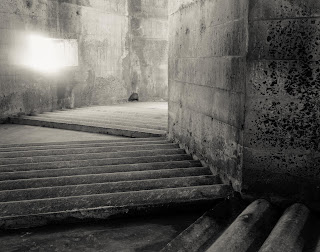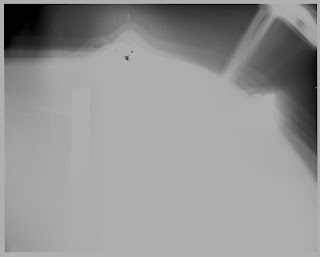After developing 35mm and 120 film for years, 5x4 came as something of a shock to the system. It brings with it a unique set of problems for which there's no easy and cheap answer. I developed my first two sheets together in a Paterson tank and it worked out fine. Then I fancied giving the "taco" method a try - popping rubber bands or hair bands around the film forcing it into a taco shape and doing up to four at once in the Paterson tank - but it was a disaster.
I'd used some new-to-me secondhand double dark slides without testing their light-fastness. My changing bag had a slight tear at a seam and I used a developing tank that I'd never used before. On top of that there was the taco method. The negatives, it turned out, shrugged off their hairbands in the tank so development was uneven. But the Tmax 100 sheets were also badly fogged and with three variables it wasn't obvious where the problem originated.
I'll have to do some testing to find out what the cause of the fogging is but I think it must be the DDSs. I'd checked them thoroughly with a torch before loading the film and there weren't any obvious light leaks but I've also checked the changing bag and tank and I can't see any problems there. I'd have thought a leaky DDS would have resulted in localised light strike but there was an all over fog to the negs. Here's the evidence. What do you make of these?
Anyway, once bitten, twice shy so that's why I decided to try tray developing. There are two ways of doing it - one at a time or multiple sheets. On the basis that it's better to learn to walk before you run (this is beginning to read as if it should be World Platitude Day), I went with the single sheet approach. The danger from tray processing single sheets is that the developer can slop back off the sides of the tray and over-develop the edges of the negative. The use of a tray two sizes bigger than the neg is advised to circumvent this but then you use more chemicals. I got out two 5x7 trays and decided to do two negs at the same time but in separate trays.
Rather than agitate in the normal way by lifting up the tray by each corner in succession, I thought I'd give brush agitation a shot. This is something that I read about and simply involves swabbing the negatives when they're in the developer with a soft artist's brush. That takes care of agitation without risking uneven development. It's a popular technique with photographers who shoot 10x8 and up.
First of all, I had to black out a few minor light leaks poking round the darkroom door. Then I lined up the two 5x7 trays with their jugs of developer - Rodinal at 1+50 - by their sides, and 10x8 trays of stop and fix. Lights out, Adox CHS 100 II film out of the DDS and into the trays, pour on the developer and start the clock. I went from neg to neg with the brush so they got regular, if not constant, agitation. Ten minutes later, one neg went into the stop face down and one face up and then into the fix in similar manner.
I waited about a minute, switched the lights on and found that the negs had hardly started to "clear" at all - I'd used old print fix instead of the fix I keep for films! Out went the weak stuff and in went the hard stuff. The negatives came out looking just fine.
 |
| The eagle-eyed will have spotted that this shot is upside down. What can I say? It looks better this way! |
As you can see, they're a couple of shots from inside the wartime pillbox that I wrote about here. If you compare the 5x4 shots with those taken with a 28mm Zeiss lens on my 35mm Contax 137MA in the earlier post, you'll notice that the daylight coming in through the windows of the pillbox really shows up the shortcomings of the 127mm Kodak Ektar lens on my old Speed Graphic. Look at that flare! I don't mind some flare on old lenses but this has obliterated any detail outside the pillbox whereas with the 28mm Distagon it's controlled very well. Still, I suppose it adds a fitting olde worlde charm. The front tenement of the Ektar is quite badly scratched. It's fine for some shots but it's up against it here. It would look great in a forest with a nice glow imparted to light filtering through the branches.
And what of Adox CHS 100 II in 5x4 format? It's difficult to say a lot other than that the negatives look very nice. They're fine-grained, sharp, have plenty of shadow detail at 100 ISO in Rodinal, dry quite quickly with no nasty surprises and have nice tonality. I'll get them in the enlarger next week and make a couple of prints and check the negatives through a grain magnifier to get a better idea. As I found with the 35mm Adox, it's certainly a vice-free film that seems rock solid and dependable.









It's really a general rule (at least for me as a researcher) that you only ever change one variable at a time, and even then it's often very difficult to interpret the results. Your confusion when changing three at once is perfectly understandable :-)
ReplyDeleteI do think that you should aim for a process that is reasonably painless; that, more than anything else, will determine whether you'll stick with LF or not after all.
So, perhaps revisit the taco method after first making sure your holders and other components are good?
Oh, and about the shots you posted: I absolutely love the soft glow from the window openings. It gives the entire scene a sense of etherealness, as if it's not quite connected to mundane reality.
ReplyDeleteNice one Bruce! I still think you should try tray development with that agitation technique I told you about . .
ReplyDeleteThere must be some synergy going on today though as we've both posted photos made on Adox and developed in Rodinal on the same day . . spoo-hoo-hoo-ky!
Hello Bruce dare I say it? your dev tank used for the taco method had its centre feed tube installed , my first time with the taco method I left it out so I could install 4 negs easier. Of course this stops the tank being light tight.Apologies if I am suggesting the obvious ....
ReplyDeleteAndy, there's nothing too obvious that I can't overlook it. In this case, though, I did indeed have the tube in the tank. I think the bands I was using just weren't tight enough on the tacos and slipped off during agitation. I've got a better idea for developing 5x4 and will write a post in a wee while.
ReplyDeleteI use the MOD54 in a Paterson tank which allows 6 sheets of 5x4 to processed at once. No muss, no fuss.
ReplyDeleteTrue Nasir and well spoken of by those who use it. However, and maybe it's because I'm Scottish, I baulk at paying £45 for a small piece of injection moulded plastic. Out of principle, I'll stick with trays!
ReplyDeleteThe front tenement of the Ektar is quite badly scratched.
ReplyDeleteI should demolish it then!
Did I really write that? Bloody predictive text! Think I'll just leave it though for a laugh and promote you to chief proof reader...
ReplyDeleteI really love brush development for my my 8x10 negatives. There's something very zen about it. Only 8x10 that doesn't work with for me is x-ray film!
ReplyDeleteFor 4x5 it's the taco method for sure.